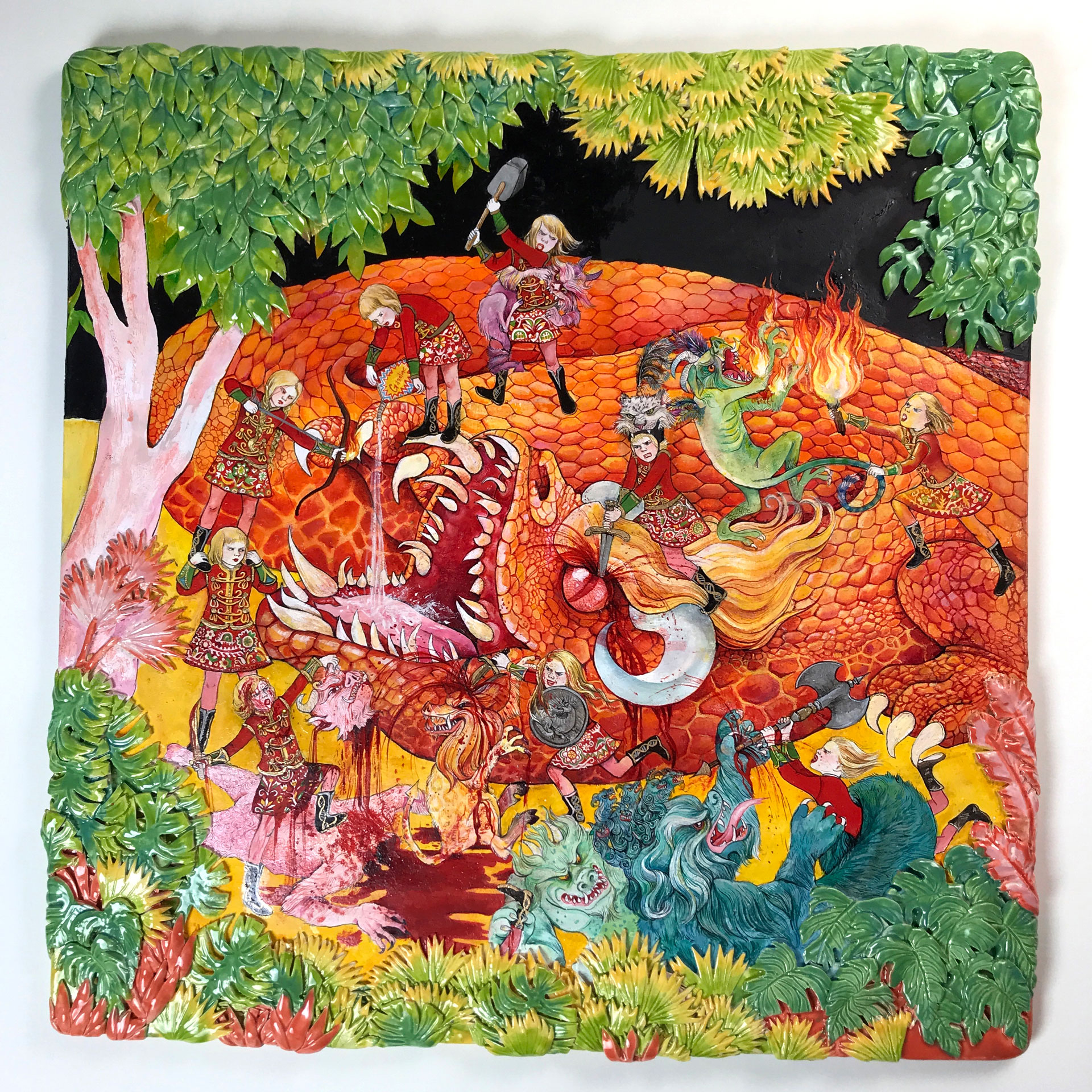HC SVNT DRACONES
The Hunt-Lenox Globe is the oldest surviving terrestrial globe that depicts the Americas. Dating from around 1510 AD, the engraved copper sphere captures the land masses commonly known at the time amid a sea of meticulously drawn waves. In the area of southeast Asia is written the Latin phrase, “HC SVNT DRACONES,” or “Here be dragons.” Perhaps a reference to Marco Polo’s ventures into the Kingdom of Dragoian (Sumatra), the phrase and derivations thereof were later used by cartographers to signal a warning against trespassing, unseen dangers, or poorly charted territories. Other maps would simply depict strange creatures near the shores or rolling in the waves—these creatures were mythical scare tactics.
The act of mapping territory is never completed. Borders and shores themselves are unmappable except as flattened abstractions. The mathematician Benoit Mandelbrot meditated in his essay “How Long Is the Coast of Britain?” (1967) and in his book The Fractal Geometry of Nature (1983) that when zooming in on a coastline, details become more pronounced. What may have been seen as a straight line, and easily measured, becomes a series of curves, articulations, and “corrugation,” each adding to the length of the border.1, 2 As those corrugations are magnified, more detail is seen and more length added. Each level of detail leads down a path of infinite length. How, then, is the infinite mapped, and what lies in the unmapped areas?
The artist couple Casey Jex Smith and Amanda Smith engage in acts of mapping and world creation. Their inexorably detailed and fantastical worlds reveal alternate realities, prototyped allegorical futures, and fictional inner monologues.

2013, 2013
Pen on paper
38 × 58 in.
Casey Smith’s Micron pen and colored pencil drawings are Boschian visions that cull inspiration from Dungeons & Dragons, Métal Hurlant, video game cartographies, the history of modern Western art, and Judeo-Christian mythology. Blemmyai wielding clubs converse over a sleek modernist structure, crashing waves of impending doom are barely held at bay by a prophet, and an overgrown greenhouse cradles monuments, statuary, and urns in its thick foliage. Each drawing resembles an isometric map, replete with monsters and border-like boundaries. Taking months to complete, these drawings are covered with minute marks akin to etching—every surface being considered and labored over. Some of the narrative vignettes in each drawing are discernible while others are buried under layers of personal or archaic symbolism and made inscrutable. The scenes spill to the edges of the paper, hinting at a sprawling universe of chaos and monstrous hybridity that is as fascinating as it is grotesque.

2016, 2016
Pen & ink, colored pencil, gouache, and gold leaf on paper
38 × 58 in.
Amanda Smith’s ceramic works are populated solely by young girls in smart frocks engaged in various acts of warfare. In Dragon (2019), a legion of uniformed girls wielding poison, a torch, swords, and an axe attack a blonde coiffed dragon and his minions. Tree of Social Mobility (2018) depicts various girls sitting on branches of a tree. The girls in the lower branches wear plain white clothing, while in the upper branches more colorful and ornamented clothes are worn, including a MAGA hat topping a tea-sipping maid. A girl in the upper left of the tree aims a flaming arrow at the girls attempting to traverse a ladder to an upper bough. These allegories, in the age of Trump and political subterfuge, illustrate social woes and play out fantasies of overthrowing the system and taking down the head dragon with his tousled mop of bleached hair.

Dark Money, 2017
Ceramic, oil paint, gold leaf, rhinestones
12.5 × 12 × 1 in.
Right: Amanda Smith
Tree of Social Mobility, 2018
Ceramic and oil paint
15 × 12 × 0.5 in.
Her executions are tightly detailed and complex, with layers of ceramic foliage framing the painted scenes. Her depictions recall Henry Darger, but without the pedophillic undertones or indecipherable personal narratives. The work revels in visual lavishness while railing against political and economic excesses and inequalities.

Dragon, 2019
Ceramic and oil paint
16 × 16 × 1 in.
Drifting in the corners of the space are piles of hundreds of thin foam characters—each lovingly drawn and cut out from brightly colored sheets of thin craft foam. Smith created these with her son and daughter over the course of years. Responding to requests from her children, Smith would render Spider Man’s entire family complete with spider wife, spider son and daughter, and spider baby, Miss Frizzle’s head on a bat’s body, Pokémon characters, and inventions by the artist herself. Over time, her children joined in on the making of the characters rather than simply petitioning. The result is a cacophonous accumulation of colors, styles, and imaginations that reflect the content of the drawings and ceramic paintings on the walls. When viewed all together—myths, parables, histories, and characters—there is a distinct sense of turbulent and childlike play as these artists make visible the manic excesses of ideas and inputs they experience. They explore and map their imagined worlds one area at a time while warning of the perils that lie inside and outside defined spaces. Here be dragons, but they can be killed.